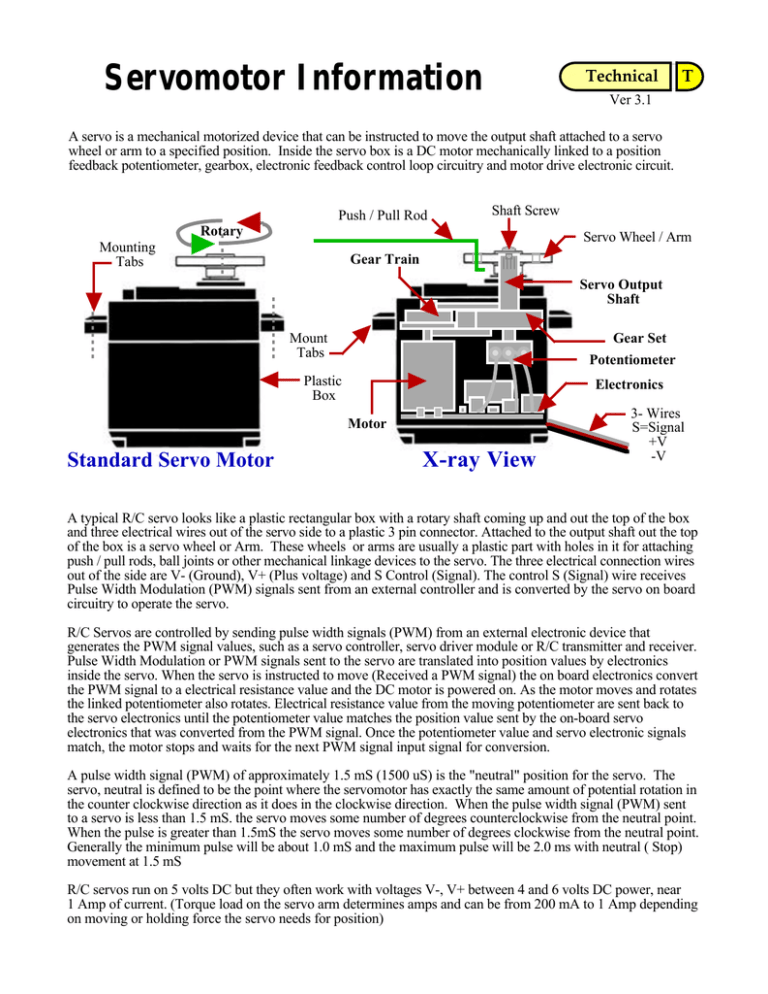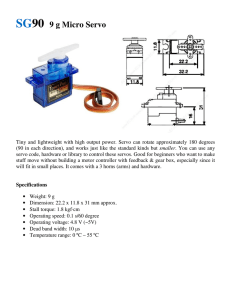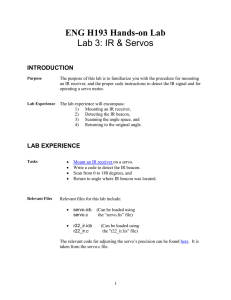
Servomotor Information
Technical
T
Ver 3.1
A servo is a mechanical motorized device that can be instructed to move the output shaft attached to a servo
wheel or arm to a specified position. Inside the servo box is a DC motor mechanically linked to a position
feedback potentiometer, gearbox, electronic feedback control loop circuitry and motor drive electronic circuit.
Push / Pull Rod
Shaft Screw
Rotary
Servo Wheel / Arm
Mounting
Tabs
Gear Train
Servo Output
Shaft
Mount
Tabs
Gear Set
Potentiometer
Plastic
Box
Electronics
Motor
Standard Servo Motor
X-ray View
3- Wires
S=Signal
+V
-V
A typical R/C servo looks like a plastic rectangular box with a rotary shaft coming up and out the top of the box
and three electrical wires out of the servo side to a plastic 3 pin connector. Attached to the output shaft out the top
of the box is a servo wheel or Arm. These wheels or arms are usually a plastic part with holes in it for attaching
push / pull rods, ball joints or other mechanical linkage devices to the servo. The three electrical connection wires
out of the side are V- (Ground), V+ (Plus voltage) and S Control (Signal). The control S (Signal) wire receives
Pulse Width Modulation (PWM) signals sent from an external controller and is converted by the servo on board
circuitry to operate the servo.
R/C Servos are controlled by sending pulse width signals (PWM) from an external electronic device that
generates the PWM signal values, such as a servo controller, servo driver module or R/C transmitter and receiver.
Pulse Width Modulation or PWM signals sent to the servo are translated into position values by electronics
inside the servo. When the servo is instructed to move (Received a PWM signal) the on board electronics convert
the PWM signal to a electrical resistance value and the DC motor is powered on. As the motor moves and rotates
the linked potentiometer also rotates. Electrical resistance value from the moving potentiometer are sent back to
the servo electronics until the potentiometer value matches the position value sent by the on-board servo
electronics that was converted from the PWM signal. Once the potentiometer value and servo electronic signals
match, the motor stops and waits for the next PWM signal input signal for conversion.
A pulse width signal (PWM) of approximately 1.5 mS (1500 uS) is the "neutral" position for the servo. The
servo, neutral is defined to be the point where the servomotor has exactly the same amount of potential rotation in
the counter clockwise direction as it does in the clockwise direction. When the pulse width signal (PWM) sent
to a servo is less than 1.5 mS. the servo moves some number of degrees counterclockwise from the neutral point.
When the pulse is greater than 1.5mS the servo moves some number of degrees clockwise from the neutral point.
Generally the minimum pulse will be about 1.0 mS and the maximum pulse will be 2.0 ms with neutral ( Stop)
movement at 1.5 mS
R/C servos run on 5 volts DC but they often work with voltages V-, V+ between 4 and 6 volts DC power, near
1 Amp of current. (Torque load on the servo arm determines amps and can be from 200 mA to 1 Amp depending
on moving or holding force the servo needs for position)
Servo Information
Technical
T
SERVO RATINGS
The most common details available on a servo are its speed and torque rating. Nearly all servo packages are listed
with brand name, model name/ number, speed, and torque output at 4.8 volts and 6.0 volts. Some information about
metal, plastic gears or ball bearings may also be listed.
SERVO
SPEED
o
60
Time (Seconds)
0 to 60 Degrees
60 Degrees
SERVO SPEED
Servo Speed is defined as the amount of time ( in seconds)
that a servo arm attached to the servo output shaft will
move from 0 to 60 degrees.
Note: The lower the time (Seconds) the faster the servo
can move an attached wheel or arm.
Servo Speed is measured by the amount of time (in seconds)
it takes a 1 inch servo arm to sweep left or right through a 60
degree arc at either 4.8 or 6.0 volts. A servo rated at 0.22
seconds/60 degrees takes 0.22 seconds to sweep through a 60
degree arc. Some of the fastest servos available move in the
0.06 to 0.09 second range. In some servos, faster speeds may
lower torque available.
BPE
SERVO TORQUE (Power)
SERVO
TORQUE
16 oz-in on 1"
arm = 1 lbs lift
1" Arm
BPE
Weight
(16 Ounces)
16 ounces (oz)
= 1 pound (lbs)
Servo Torque is defined as ounce-inch (oz-in)
The total push / pull power a servo can apply on
a 1" servo arm when moving.
Servos have a certain amount of torque (strength) that is
generally proportional to their size. Servos come in all kinds of
sizes, strengths and weight. Torque is the measurement of force
given over a distance. For most servos in the USA, torque is
measured in oz-in (force in ounces times inches, or
ounce-inch). Servo Torque is measured by the amount of
weight (in ounces) that a servo can hold at 1-inch out on the
servo output arm in the horizontal plane, again at either 5.0 or
6.0 volts to see when the servo stalls as it tries to lift the weight
horizontally. The reported result is a measurement like this:
Servo XYZ = 100 oz/in. @ 6.0 V. That means that Servo XYZ
is capable of holding 100 ounces using a 1 inch output arm
without excessive deflection at 6.0 input volts. To convert oz-in
to kilogram-centimeters (kg-cm) just divide by 13.9
Examples: Servo-A has 42 oz-in of torque
42 divided by 16 = 2.63 Lb-In. of force on a 1" servo arm
Servo-B has 2.5 oz-in of torque
2.5 divided by 2 = 1.25 Oz.-In. of force on a 2" servo arm
Servo-C has 36 oz-in of torque
36 divided by 4 = 9 Oz.-In. of force on a 4" servo arm
Note: If you need to know how many pounds a servo can push or lift on a 1" servo arm, divide the oz-in by
the number 16. Different sized arms can be used. Use the length of the arm and divide the oz-in value by the
arm length. Ounces divided by 16, for Pounds. Inches divided by 12 for Foot.
Copyright © 2007 -2015 Blue Point Engineering All Rights Reserved
Servo Information
SERVO RATINGS
Technical
T
SERVO POWER (4.5- 6.0 VDC)
Servo Power is defined as the amount of DC Voltage
needed to operate a Servo without damage.
4.5 to 6.0 Voltage
Servo operate from 4.5 to 6.0 volts DC. At the higher voltage
servos tend to be faster and sometimes stronger, but can heat up
faster when stalled or in a hold position with stress forces
against the servo output shaft. Some servo controllers require a
separate power source from the control source to deliver the
higher 6.0 Vdc. The current drain (Amps required) depends on
the torque being put out by the servo motor and can be in excess
of one amp if the servo is stalled under load.
It is best to calculate 1 Amp per servo when figuring power
supply needs for most servos.
Servo
Connector
(S) Signal =Yellow (PWM Signal)
(+) 5 Vdc = Red
(-) Ground = Black
Battery Power
Conversion Set-up
R/C Servo
2.1 mm
+ Vdc
center
- Vdc
outside
+
+5 Vdc
- Gnd
Black (-)
+5400 mA
9 - 12 Vdc
2
1
3
Red (+)
7805
Regulated
Wall Power Supply
(5 Vdc @ 2 Amp)
7805
Voltage Regulator
Battery Clip
Connectors
Heatsink
10 uF
Capacitor
05
1 = Input (9 -12 Vdc)
3 = Gnd
2 = Output (+5 Vdc)
78
Battery Cells
Power
Connection
1
3
2
Copyright © 2007 -2015
9-12 Vdc to +5 Vdc Converter
Voltage Regulator
7805
10 uF
Capacitor
9-12 Vdc Supply
Battery Supply
Heatsink
Blue Point Engineering All Rights Reserved
Servo Wire Information
PWM Control Signal
1.0 mSec to 2.0 mSec
Technical
2.0 mSec
B
1.5 mSec
A
1.0 mSec
C
Positions
T
R/C Servo
Connection
Servo Power 5- 6 VDC
- Black
- Red
- White
- Black
- Red
- White
GND (-)
POSITIVE (+)
SIGNAL (S)
(FUTABA TYPE SERVO)
Servo Connector
3 Pin Block
Standard +5 Vdc
R/C Servo
PWM Signal
1.0 mSec to 2.0 mSec
Servo Wire Code
Servo Type
Positive (+)
Signal (S)
Negative (-)
Cirrus
Red
White
Black
Futaba - J
Red
Black
JR
Red
White
Orange
Hitec
Red
Black
Airtronics
Red
Red
Yellow
Orange
White
Black
Blue
Black
White
Orange
Black
Red
Airtronics - Z
Red
Fleet
Red
GW
Red
Copyright © 2007 -2015
Blue Point Engineering All Rights Reserved
Brown
Black
Black
Black
Brown
R/C Servo Function
Technical
T
CW - ClockWise
CCW - Counter ClockWise
OFF / HOLD
Linear Positions
A to B
B to A
A
Positional Locations
0 - 90 Left
0 - 90 Right
B
Modified Servo for
Continous Rotation
Vertical Rotation
0- 90 Left
0 - 90 Right
180 - Left / Right
Servo
Mount
Horizontal / Vertical
Rotation 180 Degrees
Close
Servo Arm
BPE
Servo
Ball
Joint
Servo
Pivot
Point
Open
Fixed Mount
Servo
Servo
Wheel
Good Push Alignment
Close
Pivot
Point
(Brass Hinge)
Pivot
Point
Poor Push Alignment
Copyright © 2007 -2015
Open
Servo
Ball
Joint
Blue Point Engineering All Rights Reserved
Servo
Wheel
Servo Mechanics
Parallel Movement
Servo
Wheel
Ball
Joints
Horizontal
Ball Joints
(Brass Hinge)
Push Rod
Overtravel
Control Bend
BPE
Horizontal
Pivot Points
(Hings)
Servo
Servo
Wheel
Ball
Joints
Pivot Points
Pivot Points
Servo
Ball Joint
Servo
Force
Ball Joint
Servo Arm
A
BPE
T
(Butterfly Wings)
BPE
Opposite
Movement
Technical
Good
Ball Joint
Setup
Threaded
Push Rod
Servo
Side View
B
Eye Ball
Pivot Point
Servo
Eye Ball
Eye Ball
Pivot Point
Ball Joint
Plastic
Eye Ball
Copyright © 2015 Blue Point Engineering All Rights Reserved
Servo
Mount
Servo Arm
Servo
Side View
Servo
Force
Very Best
Ball Joint
Setup
Servo
Mount
Servo Centering
Technical
T
R/C servos are usually mechanically stopped from moving at full rotation. They have limited rotation through a
mechanical, plastic block on the internal gearing and can rotate about 90 to 180 degrees or less only. Servos are
unable to continually rotate and usually can't be used for driving rotating wheels. A servos precision positioning
makes them ideal for robotics and animatronics, since servos are self contained with control loop circuitry, drive
circuits, servo position, speed control, and are very easy to control by an external device such as a electronic servo
controller board used in animatronic character and robotic applications.
Servos are dynamic devices that when instructed to move position, will actively move to hold the position, If for
example a servo is instructed to move in the clockwise position and an external force is present and pushing
against the servo such as a mechanical linkage, the servo will resist being moved out of that position or continue
to try and move to the instructed position, even if the servo arm is incorrectly placed on the motor shaft, until
powered off. It is for this reason that every servo output arm or servo wheel used should be placed into the
neutral position before instillation into your project.
Setting the servo arm or wheel to the neutral position prevents stress to the servo motor, damages to the
electronics and provides wider movement ranges and angles for operating the mechanical linkages connected to
the servo arm or servo wheel.
Positional Locations
0 - 90 Left
0 - 90 Right
180 full left to full right
CW - ClockWise
CCW - Counter ClockWise
OFF / HOLD
R/C Servo
Servo Wheel or Arm
Servo
Connector
Servo
Modified Servo for
Continous Rotation
(-) = Black Wire
(+) = Red Wire
(S) = White/Yellow Wire
Horizontal / Vertical
Rotation 180 Degrees
(-) Ground
(+) 5 Vdc
(S) Signal
R/C Servo
Copyright © 2007 -2015
Blue Point Engineering All Rights Reserved
Servo Info and Centering
Technical
T
How to Determine the Center Position of a R/C Servo
Automated Servo Center Position
There are several ways to do this:
( See Servo Checker Operation Guide )
The best and easiest way to set a servo's center position is to connect the servo to a servo checker or
tester. There are several low cost servo checkers worth purchasing and having in your toolbox if
you plan to work with servos. To use a Servo Checker simple set the Servo Checker to its automated
center position and let the controller move the connected servo to center. If the servo arm is
pre-attached, you may have to remove the servo arm on top of the servo shaft and re-position it back
onto the servo shaft center point. The servo is now ready for instillation. Once centered place the
servo arm on top of the servo shaft, secure it with servo screw and install the servo as needed or
carefully remove the servo arm from the servo if not needed for instillation. Do not move the shaft at
this point, if it moves, simply repeat the above procedure to find the servo center again.
Manual Servo Center Position - Steps:
Carefully place one of the servo arms or wheel onto the servo shaft, mark a reference line through
(across) the servo arm or wheel center point.
Slowly and carefully rotate the servo arm or wheel by hand as far to one side as it will go, do not
force servo arm / wheel.
Mark a line on the servo base where the servo arm or wheel reference line stops.
Slowly and carefully rotate the servo arm or wheel by hand to the opposite position, as far to one
side as it will go, do not force servo arm / wheel. Should travel about 180 degrees.
Mark a line on the servo base where the servo arm reference line stops.
Rotate the servo arm back to 90 degrees between the two end reference line positions (A,B) marked
on the servo base. You may have to remove the servo arm on top of the servo shaft and re-position it
back onto the output shaft to get the center point if the arm is off center position. This should put
the servo arm close to center position.
Carefully remove the servo arm from the servo if not needed for instillation or place the servo arms
on top of the servo shaft, secure it with servo screw and install the servo as needed. Do not move
the shaft at this point. If it moves, simply repeat the above steps to find the servo center again.
SERVO CENTERING
(A)
(A) Reference Mark
Reference Mark
Reference
Line
Reference
Line
Arm/Wheel Screw
BPE
(B)
BPE
(B) Reference Mark
Reference Mark
Servo Arm
Copyright © 2007 -2015
Servo Wheel
Blue Point Engineering All Rights Reserved
R/C Servo Sizes / Types
Servo's Shown Actual Size
Ver 2.5
Servo Wheel
Micro
Pico
Technical
Mini
Tiny
Cable Wheel
Servo Arm
Servos Measured in
oz-in of Torque
Low Profile
Servo Arm
Heavy Duty
Servo Wheel
A
B
Winch Servo
1260 Degrees
3.5 Turns
Servo Arm
Linear
A
Standard
B
Wing
Profile
Rotary
5 VDC Power
Servo Wheel
High Torque
Servo
Jumbo
12 VDC
Power
10- 27 Pounds of Torque
Copyright © 2007 -2015
Blue Point Engineering All Rights Reserved
T
Servomotor Information
X-ray View
Shaft Screw
Push / Pull Rod
Technical
T
Ver 2.5
Shaft Screw
Gear Train
Servo Output
Shaft
Servo
ARM
Mount
Tabs
Gear Set
Potentiometer
Electronics
Motor
Wires
Motor
Note: A Servo stability and
longevity is determined by
the quality of the electronics,
mechanical parts. Any servo
under stress in pushing or
pulling a mechanical device
will fail eventually.
Never let a servo Hum, shake,
or push / pull beyond its
limits.
Servo Components: Best -vs- Good Parts
BEST
Motor
Gear Train
Potentiometer
METAL BALL
BEARING
GOOD
BRONZ / PLASTIC
INSERT BUSHING
BEST
GOOD
METAL GEARS
PLASTIC GEARS
Wires
Ground
Power
Signal
Copyright © 2007 -2015 Blue Point Engineering
All Rights Reserved
Servo Setup Mechanics
Technical
T
Ball
Joints
Switch
Switch
Switch
ON
SERVO
SERVO
Switch
OFF
Switch
ON
Ball
Joints
Push
Rod
Ball
Joints
LEVEL -1
SERVO
Ball
Joints
Flex
Cable
Ball
Joints
Ball
Joints
LEVEL -2
SERVO
Ball
Joints
Ball
Joints
Threaded
Rod
SERVO
Pivot
Copyright © 2007 -2015
Blue Point Engineering All Rights Reserved
Servo Mechanics
Technical
T
Different
Pivot Points
Servo
BPE
Servo Horn or
Bell Crank
Pivot
Point
Different
Pivot Points
Push Rod
Overtravel
Control Bend
Servo
Saver
Servo
Servo Horn or
Bell Crank
Pivot
Point
BPE
BPE
Commercial Servo
Saver
with internal limit
Push Rod Overtravel
Control Bend
BPE
Servo
BPE
Servo
Push Rod Overtravel
Control Bend
Simple Servo Saver
Prevents servo damage from
mechanical limited movement
A
B
Copyright © 2007 -2015 Blue Point Engineering
All Rights Reserved
Servo Mechanics
Pivot
Point
Motion
90 Degree
Bell crank
Ball Joint
Ball
Joints
Multiple
Motion Points
to
Servo
Ball Joint
Motion
Motion
to
Servo
Servo Wheel
T
Motion
Pivot
Point
Technical
Ball Joint
BEST
Ball Joints
Servo Arm
Best
Pivot
Point
Long
Movement
Servo
Increased
Movement
Short
Movement
Mount Servo in-line
with push rod to obtain
longest movement arm.
Servo
Arm
Good
Short
Movement
Copyright © 2007 -2015 Blue Point Engineering All Rights Reserved
Limited
Servo
Animatronic Mechanics
SIDE VIEW
EYE Ball Control
L/R Motion
Technical
Plastic
Eye Lids
Plastic Eye Lid
Attachment Point
(Between Eyes)
Servo
Support
Eye Lid Motion
Bracket
Pivot Point
Pivot Point
EYE
Servo
Support
Threaded Push Rod
Eye Ball
Pivot Point
Ball Joint
Ball Joint
Plastic
Eye Ball
Eye Lid Servo
Servo Support
FRONT VIEW
Plastic Eye Lid
Attachment Point
Plastic
Eye Lids
Support
Support
Ball Joint
Copyright © 2007 -2015
Blue Point Engineering All Rights Reserved
Motion Bracket
Pivot Point
Support
Eye Lid Motion
Bracket
T



